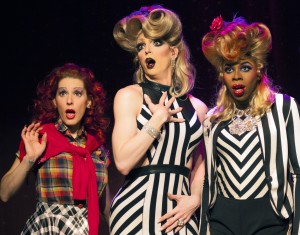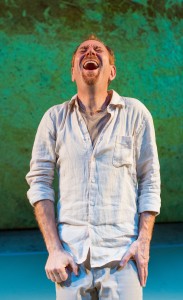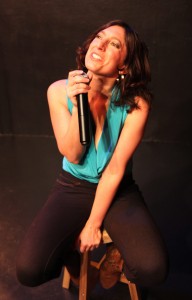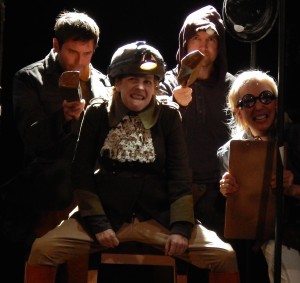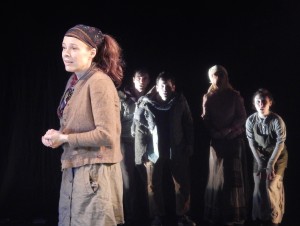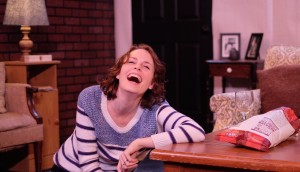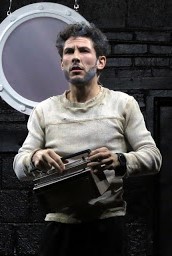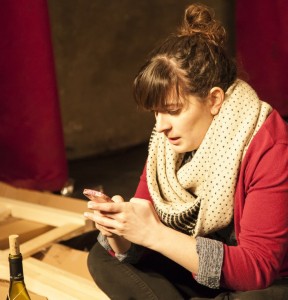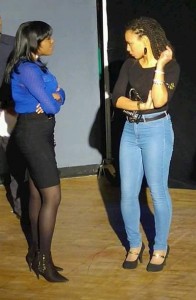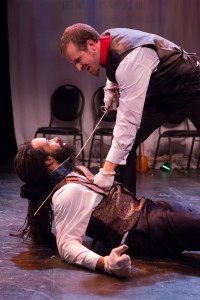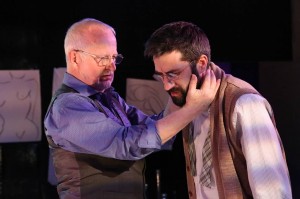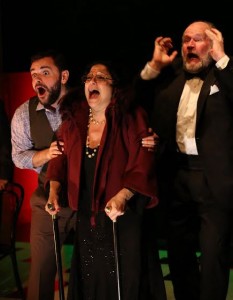What’s odd about Body: Anatomies of Being at the New Ohio Theatre, is that, as much as it wants to break the audience out of being shocked by nudity, the script doesn’t measure up. The dialogue goads the audience to be comfortable with the body and all of its functions, “Wake up. Fart. Pee. Blow nose while pooping. Burp. Yawn. Drink water. Burp. Cough. Blow nose. Pick at clogged hair follicle under right arm. Burp.” But seriously, to what end? When all the actors have plucked and trimmed their pubic hair to a landing strip, are you really that comfortable with the body? A number of challenges steer this production off purpose.
No Words…
The thing most everyone loves about birds is their ability to fly, yet one of the first things we do is catch them and put them in a cage. The same can be said of love. Told without a single spoken word, Butterfly, currently at 59E59 Theaters, unwraps a story of a kite-maker who is courted by a customer but is smitten with a butterfly catcher. The hour-long production is rich with symbolism, European and Asian sensibilities, and movement choreographed to haunting original music.
Vive ‘Le Dingdong’!
Director Hal Brooks unbridles five actors in The Dingdong, Mark Shanahan’s updated adaptation of Georges Feydeau’s 1896 farce Le Dindon. He propels it even further into the absurd by having those five actors bring to charming, boisterous and nuanced life 12 distinct characters.
The farce begins with Lucy Vatelin (Rachel Botchan), a married woman, attempting to slam the door on an overzealous suitor, Pontegnac (Bradford Cover). With Pontegnac’s arm and leg precariously lodged in the door, she is leaning against it, insisting he go away. “Everyone this side of the Seine heard you shout that you wanted to make passionate love to me!” she complains loudly, while screaming for her husband to save her. Unfortunately, Pontegnac is an old friend of her husband (Chris Mixon).
Lucy has another suitor, Redillon (Brad Heberlee), who calls on her as well. With Vatelin out of the room taking a business call, Redillon and Pontegnac square off. Meanwhile, Mme. Pontegnac (Kelley Curran), suspecting her husband's infidelity, has followed him to the Vatelins’ home, where Lucy, worn down, makes a pact with Pontegnac, agreeing to have an affair with him if her husband should ever be unfaithful. Pontegnac knows full well he hasn't been.
The first-act characters include Fabiola (also Curran) as Vatelin’s Italian lover, who has traveled to Paris (with her Hungarian husband) to find him and profess her love. The second act introduces even more, at The Hotel Ultimus, with doors slamming, a 17-year-old bellboy and a Parisian policeman (both played by Heberlee), luggage mix-ups, a French chambermaid, an old, practically deaf woman (Botchan) with uncontrollable flatulence, and a New Yorker named Mandy (Curran).
Two multifaceted performers capture the pure essence of farce in their multiple roles. Kelley Curran bursts onto the stage as the epitome of a sophisticated, bold Frenchwoman and shortly after reappears as an Italian lover with all the bravado of an early Sophia Loren. Act II opens with Curran as Mandy and, only to outdo herself, she closes the play as a fetching French maid. Wigs, costumes and shoes take an actor only so far in a role—Curran is each character.
Heberlee is also a delight, energetically embodying three characters—the flamboyant, sex-driven Redillon (who is a doppelgänger to Feydeau), the bellboy and the policeman. It is his role as Redillon in Act I, at one moment writhing on the floor and professing his love to Lucy, and in the next attempting to explain to Vatelin why he is on the floor (he is cleaning, after all) that is the most endearing. During the standoff with Pontegnac the actors pose like two preening cocks in the farmyard, arguing who is the greater lothario (“I would never discuss matters of intimacy with another man’s wife”).
Cover appears to have the most difficulty playing multiple characters, relying on his best Tim Conway impression, at times shuffling or gasping before each line. Act I finds him and Botchan in awkward and unnecessary movements with odd pacing.
Designing a 1938 French townhouse, Sandra Goldmark uses striking black and white striped walls, a sunrise-yellow floor, and tone-on-tone fabric chaises for Act I. Lighting designer Mike Inwood adds a wonderful layer of sunlight streaming through a lattice window. In Act II, at the Hotel Ultimus, there are bright green and yellow panels with a matching headboard and bedspread. A brief set change and the scene becomes the Honeymoon Suite of the Hotel Rue Cromartin, where the stagehands, decked out à la Marcel Marceau, replace the fabric with bright red floral patterns, as well as a painting of the Eiffel Tower.
Working in concert with the set designer, costumer Amy Clark mixes and matches contrasting colors and patterns. Her attention to detail with smart wigs and colorful hats, down to gartered socks and Redillon’s man-about-town look, is like pure icing on a Pimm’s Cup cupcake from Prohibition Bakery.
George Feydeau is one of the most famous writers of bedroom farce, and Mark Shanahan’s adaptation is a remarkable homage. Witty banter, along with exaggerated physicality, are at the heart of The Dingdong. Even the most pursed lip might be cajoled to laugh out loud.
Performances run through May 15 at the Pearl Theatre, 555 West 42nd St., (212) 563-9261. Tickets are $65 regular, $85 premium ($40 members, $20 student rush, $20 Thursday rush). Visit pearltheatre.org for specific dates and times.
Tongue, Meet Cheek
Follow Nasty Drew (no not a typo) and the Harder boy (well, there is only one after all) as they attempt to solve The Mystery of the Family Jewels, a fun, sexy, raucous evening of tongue-in-cheek comedy, a little drag (hello, family jewels?) and some outrageous burlesque. What burlesque has to do with a spoof of the teen-mystery-novel genre is a good question, but somehow they seriously pull it all together and take it all off.
The mystery is set up by Franklin W. Dixon and Carolyn Keene, respective authors of the super sleuths’ series, The Hardy Boys and Nancy Drew. Tigger! as Dixon and Fancy Feast as Keene are as colorful as their names, in a Dead Men Don’t Wear Plaid kind of way, and create a playful, publishing-world rivalry. When Dixon attempts to engage Keene in a dialogue about the Hardy Boys, she dismisses him with, “Those two boys, always carousing around in that flashy convertible, always seeking to emulate and please the Hardy patriarch. Such strong father issues.” Dixon, not to be outmaneuvered, refers to Nancy Drew’s “questionable relations with those lady ‘cousins’ of hers…” The evening is filled with double entendres (“It’s even more colossal than my ‘Case of the Mysterious Hole in the Wall’”) and early Batman/Boy Wonder dialogue (“Jumpin’ catfish, what is it?”) Laughter, mixed with a ton of silliness and a whole lot of skin, will certainly chase the workday blues away.
Dixon and Keene introduce Nasty Drew (Nasty Canasta) and That Harder Boy (Chris Harder) who take on solving The Mystery of the Family Jewels, which is written and directed by Harder. In the course of the investigation, they meet with the buxom Lady Sussanah LaVeux De Cock; her bawdy cousin Mona Crackers; randy Police Chief McDaniels; the mechanic with lesbian tendencies Nadina North; and Cecilia “Sissy” LaVeux De Cock, Lady LaVeux De Cock’s estranged “twin” sister, among others. (The characters are played by a rotating cast of performers based on the show’s schedule.)
In The Mystery of the Family Jewels the puns, sight gags and extraordinary burlesque keep coming. Pearls Daily as Mona Crackers, who is purportedly from the wrong side of the tracks, delivers a 1920s style flapper number in a wonderful homage to the queen of burlesque, Gypsy Rose Lee. Nasty Canasta follows with a funny and entertaining undercover number employing a fake nose, glasses and mustache, which at first glance seems silly, but just wait.
Feast, who also plays North, Brookeville’s “semiretired, show-stopping sensation of stage and screen,” performs a most bodacious burlesque piece and steals the show with dialogue in the manner of legendary Mae West. Not to be outdone, the men have their own time baring all in the limelight. Ben Franklin as Police Chief McDaniels pulls off “You’ve gotta have a gimmick” burlesque that is straight—in this context used loosely—from Gypsy with hula hoops, the unbelievably limber Tigger! takes it down to a sock puppet, and Chris Harder woos the fans in his unforgettable, charming style, sock garters and all.
The show is sponsored in part by a few local businesses, and commercials are written into the script to promote them. It’s a fun gimmick that needs more attention to detail in the venerable, radio announcer style. Although issues with the show's sound and lighting may be attributed to the slightly random performance schedule, the biggest drawback is that some comic lines can’t be heard and sound levels overpower a few of the songs.
It’s evident that the Mystery of the Family Jewels has a following with a rowdy, adoring audience in attendance, and it’s easy to see why. The cast, taking their lead from Harder and Canasta, has a blast giving their all and baring all. If they break character or a prop doesn’t appear as expected, don’t be surprised, it just adds to the frivolity.
Performances of Mystery of the Family Jewels are 10 p.m. April 29 and May 13 and 9:30 p.m. May 1 and 15 at the Laurie Beechman Theater inside West Bank Cafe (407 West 42nd St.at Ninth Avenue). The theater is accessible from the A,C,E,N,R,V,F,1,2,3 trains at 42nd Street. Tickets are $22, plus a $20 food/drink minimum. A $35 VIP ticket includes reserved seating, a gift bag and a meet-and-greet. To purchase tickets, call 212-352-3101 or visit www.SpinCycleNYC.com.
Shards of Light
How many times has someone attempted to explain the "situation" in the Middle East? And, of those times, how many have felt one-sided? No matter how hard the best of us try, the reasoning often has a bent, a leaning toward one side or another. “It’s complicated,” after all. In Wrestling Jerusalem, Aaron Davidman presents 17 voices of men, women, Israelis, Palestinians, Brits, doctors, farmers, and rabbis, among others, in a manner that can be heard and understood with refreshing deference. His affinity for the material, as well as the struggle and heartbreak of people, is breathtaking.
As the playwright, Davidman has done his homework. “You might say it all started in 1948” or “You might go back to World War I,” he says, but wherever you might think he is leading you, it’s not where he’s going. Wrestling Jerusalem is in uncharted territory. Six Day War, Intifada, United Nations Resolution 181, Invasion of Lebanon, or the settlements: he unwraps the causes and the concerns, the politicians and the terror attacks with such deftness that he draws the audience into being concerned regardless of any predilection they had when they walked in. He causes one to care, to want to know more. “If, if, if, if, if, if,” he declares. If only this hadn’t happened or if that hadn’t occurred, things would be different, right? It’s the manner in which he constructs the inquiry that is at heart of his invitation to look deeper, practically challenging the audience not to care.
Davidman’s skill reaches well beyond his writing. His talent as an actor, adept at the nuance and complexities of characterization, is thoroughly engaging. Each of the 17 is based on people he has encountered in his attempt to understand the Israeli-Palestinian conflict, whether in North America or on his travels through Israel and Palestine. Like a chameleon he embodies the subtleties of Farah, a Palestinian woman in her 30s, or Professor Horowitz, a British man in his 50s, or Rabbi Moses, an American in his 60s. Davidman sings Yiddish songs from his days at children’s camp to the cherished “Shalom Aleichem.” He dances to folk songs from the homeland as Allen Willner’s lighting creates shadows around him. It is equally as powerful to observe him on the ground pushing invisible sand, as it is to viscerally feel his fear crossing the Israeli border into Palestine; he is that passionate.
The backdrop for this extraordinary experience is a beautiful, yet simple painted tarp along the back wall designed by Nephelie Andonyadis. At times it has the feeling of windswept sand and at others a ragged mountain range, depending on the lighting of Willner who colors the backdrop and space with rich oranges and yellows, or a vibrant blue, and then in an instant throws Davidman into the harsh, bright sunlight of the Ben Gurion tarmac. Bruno Louchouarn is responsible for original music and haunting sound effects. Credit for the keen direction of Wrestling Jerusalem goes to Cuban playwright and director Michael John Garcés. He brings a rich and varied background in community-focused plays, which is particularly evident in this production.
There are many profound and wrenching moments in the 90-minute Wrestling Jerusalem. Davidman’s character, Ibrahim, a Palestinian cries, “The only Israelis my children have known drive tanks, invade neighborhoods, intimidate their parents at checkpoints. The only Israelis I have known own the water trucks that deliver my water. My water.” His interaction with Rabbi Moses, who emphatically declares, “Adonai Echad does not mean there is only one God. Adoni Echad means God is One. What’s the difference? There’s a huge difference. God is One. One, not the number. One, the truth of indivisibility.”
All of which is extremely important in a landscape where people, politicians, and religion drive the conversation as to “who does the Holy Land belong to?”
“As the muezzin’s call to prayer floats out over the Wall,” Davidman tries to make sense of it all. “Please. You can hear the cry inside the cracks. Please, God, help me. Help us. The Wailing Wall holds the tears of generations.” His inquiry into the Middle East conflict may not answer any questions or even the ones everyone has come to expect, however he wrestles the word humanity into the bright light of day. “’And it’s the work of human beings,’” say the Kabbalists, “’to find those sparks, those fragments of goodness, and put them back together. It’s how we heal the world, they say.’”
Wrestling Jerusalem runs through April 17 at the 59E59 Theaters (59th between Madison and Park Avenues) in Manhattan. Evening performances are Tuesday through Thursday at 7:15 p.m. and Friday and Saturday at 8:15 p.m. Matinees are Sunday at 3:15 p.m. There is no late seating. Tickets cost $35. To purchase tickets, go to 59e59.org or visit TicketCentral.com.
I Want to be Your Friend
Very much like a schoolgirl dancing around her room, Alicia Dattner begins her one-woman show, The Oy of Sex, with a rousing version of “I Want to be Your Lover” by Prince. As she settles she begins to engage the audience by talking about sexual experiences. Dattner kids around and says, “O.K., you first.” The evening proceeds into an autobiographical journey exploring the world of sex, more specifically love and sexual addiction. “You–we–will never be the same, from this night forward.” Tall order. Her background as a stand-up comic is clearly evident by her delivery, timing, and most importantly, storytelling.
Dattner takes the audience to her early puberty days with “Dear Diary, I can’t wait until the kissing starts!” and then she practices kissing with her hand aka Señor Wences. For her high school and college years Dattner says, “it’s kind of like my clitoris was slutty, but my cervix was a prude.” Eventually she surrenders her virginity after listening to “April in Paris” when the guy she was seeing didn’t leave. “This must be what love is, right?” to her eventual disappointment, “I waited 21 years for that? It’s just his penis going in and out?” and Dattner mimics the motion with her hands. There are some great lines in The Oy of Sex as one might expect from a seasoned stand-up comic. Describing her boyfriends and sexual adventures, Dattner is often quite funny. “Max was sort of like a frat boy, without the college. Not a catch. More of a catch and release. He was so dumb that he thought anthology was the study of ass holes.” Dattner also says, “My dad's family is Jewish, and my mom's family is atheist. So I want to marry a doctor who's good enough for me, but I don't believe he exists.” Pause, rimshot. The performance rests comfortably between stand-up comedy and a working copy of a ‘chick flick.’ What’s missing is a range of emotion.
Dattner is smart, funny, entertaining, talented and full of energy. Her delivery of getting hit on by another woman, Anastasia, was complete with wild abandon even as she was faking it with "When Harry Met Sally" style. It was almost as if watching Anastasia go down on her–it was that good. When Dattner is asked to reciprocate Dattner's expression is priceless. But this performance is not just comedy nor is it stand-up. As Dattner continues through the many lovers and trips to Burning Man it gets clear that sex and love for her is a problem, and instead of a new lover she seeks help. Dealing with addictions, while serious, can be funny and still be enlightening. The confluence of a great writer with a talented actor can bring out the depth that comes with the desperate actions of an addict wrapped up with self-effacing humor. Dattner’s range remains in the realm of stand-up, and make no mistake she is quite funny.
Whether Dattner’s choice, or her director Tom Bentley-Fisher, she uses a hand-held microphone the entire performance. It is not necessary for a theater like The Bridge. As a stand-up comedian working a large house it is indispensable or it can be useful for sight gags. It is phallic, after all. However in this experience it boxed her in as a stand-up comedian. While she is quite adept at choreographing her use of a microphone it got between her and the audience limiting her range of emotion, especially as she attempts to express more vulnerability delving deeper into her 12-step program and interactions with her sponsor. On stage Dattner owns the word certitude, and she is incredibly self-assured; delivering a solo show you have to be. However, the development of an intimate relationship with the audience beyond being funny is lacking. It's as if she wants to bring more to the stage but is locked in an old paradigm.
Dattner brings the The Oy of Sex full circle, declaring, “Knowingly or unknowingly, your consciousness has been raised.” She goes on to say, “But from this moment forward, you're a different person.” Again, a tall order. There is a lot of laughs, and she brings an incredible amount of energy to the stage. Dattner opens her life up to intense scrutiny for everyone to see, but as good as a stand-up comedian as she is, and she has honed her craft, it still feels like stand-up. The raffle after the curtain call confirmed it.
The Oy of Sex runs until April 17 at The Bridge at Shetler Studios (244 W. 54 St. between Broadway and Eighth Ave.) in Manhattan. Evening performances are Wednesday through Saturday at 8 p.m. and Sunday at 2 p.m. and 7 p.m. on April 10 and 17. Tickets cost $20. To purchase tickets, call 212-868-4444 or visit smarttix.com.
“The Ring Has Awoken…”
Sam Gamgee, in the movie Lord of the Rings: The Fellowship of the Ring, righteously declares that "there’s some good in this world, Mr. Frodo… and it’s worth fighting for.” Good theater is also worth fighting for, and you may very well find yourself battling to get a ticket to see Fly, You Fools! Presented by Recent Cutbacks, it is currently playing Friday evenings at Peoples Improv Theater in Manhattan.
The Opposite of Light
Light, A Dark Comedy is a clever and smartly written play wrapped neatly with an amazing array of costumes, puppetry, lighting and media. It delivers a futuristic world ruled by an evil mayor and her equally evil, if somewhat “pretentious mystical nitwit,” sister. Sunlight has been literally sucked from the sky and leaving everyone to "stay online" or fall into darkness. No one really remembers actually seeing the sun, however, there are references and ditties scattered throughout the play that alludes to the sun. So much so that the words "day" and "light" have been replaced with the word "dim." What happens to the human spirit when subjugated by darkness and despair? And, for a young girl–what will she resort to for extra rations for her and her mother?
While pulling from modern mythology, movies and history, Light, A Dark Comedy is rich with symbolism making for an ominous, expressive tale for a modern age by playwright Greg Steinbruner. The story follows a young girl called Moth on a journey through her own darkness, from completely believing the evil Mayor to eventually confronting the truth and the Sandman. Along the way, Moth, played by Tami Stronach, encounters the Sleeper Services, who take away those who have fallen asleep. Moth also comes across the evil Mushanto Mushroom Corporation–where orphans are conscripted to work off their debt to pay for the care of the sleepers, The Underground–a rag tag group making up the resistance movement, the Queen–whose whispers cause people to sleep so that she can control their dreams, and finally Sunny and Ray–who broadcast an illegal radio show with supposedly cryptic messages for The Underground. The story languishes in the middle and it might be a tough sell for children due to the length and heavy subject matter. However, the detail in the story woven by Steinbruner and the tightly choreographed production is incredibly engaging.
Light, A Dark Comedy is brought to life by a great cast who, with the exception of Stronach, play multiple roles while creating and re-creating the stage for each scene. Here, darkness and shadows allow for characters to blend in while holding up a screen to complete the set or make a large flock of birds swirl overhead. Stronach, similar to Judy Garland in the Wizard of Oz, is the thread throughout this 90-minute journey and is rarely off stage. She, as well as the entire cast, is completely immersed in her character, movement and the story. Everything is so tightly intertwined to bring anything less to the stage could easily be catastrophic. Carine Montbertand plays the evil Mayor with great aplomb delivering a wicked, sinister character. It is her portrayal of the Mayor’s sister, The Queen, though, that appears forced. It is almost as if she is trying too hard to make her character uniquely different than the Mayor. Steinbruner's play challenges six actors, including himself, to play 16 roles in one production. With the extraordinary direction of Adrienne Kapstein the cast utilizes every opportunity to nuance 16 characters to life. From language and dialect to physical attributes and an abundance of costuming this is a challenging play both physically and mentally, and the cast made it appear seamless under her guidance. It is quite surprising when only seven actors appear on stage at curtain call.
Before all of this could take place, a talented development team created a very complex and moving production. Barbara Samuels delivers unique lighting to a relatively sunless play, Theresa Squire layers costumes for 16 characters to change into quickly, Mark Van Hare designs subtle sounds and striking music, Tom Lee designs vivid projection imagery, and Lake Simmons' delightful puppetry includes an expressive chicken laying an egg and a giant dragonfly who buzzes about the characters. Tying the vivid production together is Deb O with a steampunk style set design that utilizes three rolling “stages” and holds a multitude of props to create scene upon scene.
Light, A Dark Comedy is an unexpected 90 minutes that touches each of the five senses and is an invitation to explore the sixth. As Moth describes, “It’s on the tip of your tongue, but the name of the thing–the thing that’s missing–just doesn’t come to your lips.” It’s when Moth ventures out into the world and she comes to the crossroad of curiosity and dreaming, that she understands that only light can overcome darkness.
Light, A Dark Comedy runs until April 10 at the Triskelion Arts Muriel Schulman Theater (106 Calyer St. between Clifford Pl. and Banker St.) in Brooklyn. Evening performances are March 25 at 7:30 p.m. and matinee performances are Saturday and Sunday at 10:30 a.m. Tickets cost $18.00. To purchase tickets, visit papercanoecompany.com.
Whiskey Needs Respect
Eric Gilde’s new play the goodbye room focuses on a common experience in most everyone’s life—the death of a parent—but more important, it asks the question, “What’s left of the living?” There are those who have to handle the funeral arrangements, travel home for the service, or find a way to relate to one another during a time of grief. It’s the relating that most often gets in the way. Gilde has done an exemplary job of capturing the essence of this experience, and, as the director, creates the space for four talented actors to bring it to life.
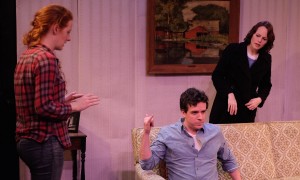
It is a detailed re-creation that, without nuanced performances, could easily come off as flat. There is nothing new, there are no great surprises and no profound personal breakthroughs in the goodbye room. However, it’s the precise manner in which Gilde wrote the dialogue, directed the actors, and how they delivered it that enhances the drama.
Michael Selkirk plays the grieving Edgar, whose wife has just passed on. Edgar has two daughters—the “good,” overworked, overwhelmed daughter Maggie (Sarah Killough) and complicated Rebecca, affectionately referred to as Bex (Ellen Adair), who married and moved to Chicago five years ago. Bex laments not coming home sooner, while Maggie plays the busy martyr who stayed behind to work and take care of the parents. This sibling story has been told and retold following the death of a parent; however, it’s Gilde’s staccato dialogue, with the characters talking over one another, coupled with the generous space between the words, where the crux is to be found. Included in this drama is the affable family friend and former love interest Sebastian (Craig Wesley Divino.)
Bex is wound tightly, from the moment we hear the car door slam to when she finally tersely reveals, “Larry and I are getting divorced.” The estrangement from her family is exemplified by her awkward attempts to console her father or hug her sister. She often finds a way to make it more about herself than anyone else. Maggie, equally tense, lets on to anyone who will listen how busy and overwhelmed she is. Sebastian has found his second family and doesn’t want to let go, always being available to lend a helping hand. Edgar is trying desperately to understand this new void in his life, even while shuffling off to make coffee or trying make sure his girls are comfortable.
It’s when he shares his Irish whiskey with Sebastian that Selkirk delivers everything that resides just behind the dialogue. “I don’t think you should come around here for awhile,” he says, pausing for a moment, then saying, “Drink up.” The rage that seethes behind his full beard and scraggly appearance is subtle yet profound.
Justin Spurtz’s set covers every base, from the 1950s paint-by-numbers framed art on the wall to the collection of family photos and the paper plates complete with grease stains left behind by the pizza. There is the patterned family sofa that has lost its firmness over the years, and the coatrack filled with winter coats and scarves. Spurtz even includes a bit of whimsy with Bex’s childhood mug.
Jacob Subotnick layers on a sound design that complements each scene, from car doors closing to LPs with crooners on the vintage stereo turntable to the subtle patter of rain. The volume of the mobile-phone ring in the handbag was on point, and the iPod selection set the scene for the sisters to share too much wine, and finally themselves, is perfect.
Gilde’s drama touches slightly on the concept of the lingering spirit of the departed, with lights flickering or the broken stereo finally playing. It’s a welcome relief from the family drama being played out, but it’s also a hint that there is more to life than silly squabbles or playing the blame game one more time. Maybe love, as messy as it can be, transcends the boundaries of this reality to remind us of what’s important.
“The goodbye room” is at the Bridge Theatre at Shetler Studios (244 West 54th St., 12th floor) through March 19. Remaining performances are Wednesdays through Saturdays at 8 p.m. and Sundays at 3 p.m., plus Tuesday, March 15, at 8 p.m. Tickets are $15 and $18 and may be purchased by visiting Artful.ly.
What Gives You the Right?
Credited as co-creators along with writer Pickard are Jonathan Camuzeaux, Lani Fu, Megan McClain and Simón Adinia Hanukai, who directs the piece. Fueled by global concerns about the environment, they are part of the eco-theater company Superhero Clubhouse, “a collective of artists and scientists” working to create “original performances via a collaborative, green and rigorous process,” according to its website. (Camuzeaux and Hanukai’s Kaimera Productions is a co-producer).
It is clear that they not only embody a worldview but also deliver it with extraordinary purpose and aplomb. Pickard’s script is powerful and concise, and he creates a character with the halting manner of Rod Serling. The play/performance progresses with such deference to the experience of the audience that the focused collaboration produces its intent boldly and with great detail.
Stephens, who carries a large share of the acting responsibility, brings all the nuance of mankind together as Humanity. While Pickard created a way of being for Joe that is consistent, the actress moves through a palette of emotions. She brought conviction and intensity to her part.
So committed were the collaborators of Jupiter to bringing a greater awareness to the issue of global energy beyond the play that the creative team secured a grant to attach solar panels to the theater. While not always enough power for an entire performance, there is a television monitor above the stage letting the audience know how much energy is used in kilowatt hours and the grams of carbon dioxide required. Additionally, after each performance is a panel discussion with the cast and a guest for those who would like to hear more. Gavin Schmidt, director of the NASA Goddard Institute for Space Studies in New York, climatologist, and co-founder of the award-winning climate science blog RealClimate, was on hand to answer questions.
The deeply moving Jupiter delivers its message in an insightful and powerful evening, and beyond.
Jupiter (a play about power) will be presented at La Mama Theatre Club (74a East 4th St.) through Feb. 28. Performances are at 7:30 p.m. on Thursday-Saturday, with matinees at 2 p.m. on Sunday. Tickets are available by calling the box office at 212-475-7710 or through OvationTix at 866-811-4111.
#IKEA Angst Emoji, Emoji
The script for Help Me Out Here, an entry in the 2016 FRIGID New York festival, pulls material from text messages written when people were drunk, iPhone notes, personal journals, positive affirmation recordings, and sprawling Post-it notes on which writers look for the meaning of existence—all while assembling a chair from IKEA. Michael Joel and Kaitlin Overton, who conceived the script, also perform and co-directed the piece; they keep their real first names as the characters.
Taking on three jobs to produce one’s own work in the theater requires a dynamic, steadfast vision to provide the ultimate experience for the audience. When it occurs, magic happens; however, even though the angst of a younger generation lost in the mobile phone/social media argument—"If I’m so connected, why do I feel so alone?"—is conveyed in Help Me Out Here, the play comes up short. Conceptually it has footing, but with only 40 minutes of material, there are too many missteps.
He attempts to go to a party but instead listens to every neurotic thought in his head, delivered as a voice-over. Soon enough he is barely managing a lame excuse to the hostess to make his exit. Meanwhile, maybe because of the wine or just because she is growing weary waiting for a response to her text messages, Kaitlin falls asleep. The parts of an unfinished chair and the instruction manual are all around her.
Kaitlin’s challenge assembling an Ikea chair against the backdrop of life is a keen metaphor for both of them. The inclusion of her character, however, lacks conviction from the playwrights, as evidenced by her lack of dialogue. Michael battles with life, world and God issues while Kaitlin listens to positive affirmation on a CD and argues with a how-to manual. This type of dialogue only reaffirms the age-old myth that men are strong and educated, while women are weak and helpless.
A different director could have brought a fresh eye to the play: one who addresses cracks in the storyline while pulling/pushing the actors to dig deeper. Perhaps because of their closeness to this material neither Joel or Overton has addressed inconsistencies in the script. Kaitlin, in a text message, asks Michael if he has a screwdriver. When he arrives they finish the chair, but without a screwdriver, they never reference the screwdriver, using an Allen wrench instead.
However, the real problem is that the directors of Help Me Out Here have given Kaitlin so little substantial dialogue and a dated female story line. “I don’t understand these instruction booklets,” she says. “I never have and I never will.” Even in the modern age of IKEA, the writing behind Kaitlin’s monologues has not allowed her character to progress. Instead, she is relegated to being either unwilling or unable to understand an instruction manual or the need to have a man come to the rescue.
The next morning, Kaitlin awakens, still surrounded by the pieces of an unfinished chair, and she calls Michael. Human interaction, not another text message, moves him to come over. Maybe, after all, it’s not so much a man to the rescue but rather the bigger picture that people can accomplish more together with a glass of wine than by going it solo. Until the playwrights, or a different director, rethink the point of the angst, there is not much to help.
A No Dominion Theatre Company production, Help Me Out Here plays at Under St. Marks (94 St. Marks Place) in Manhattan. Remaining performances are Wednesday, Feb. 24, at 7:10 p.m.; Saturday, Feb. 27, at 10:30 p.m.; and Saturday, March 5, at 12:30 p.m. Tickets are $18 for adults and $13 for students at www.horsetrade.info. For a complete list of plays presented by FRIGID New York, visit www.horsetrade.info/frigid-festival.
Nothing But the Truth
Why Not Just Tell the Truth is an ambitious, yet over-reaching, play at The Tato Laviera Theatre. It is extremely current and very raw, with great music selection for a television show. Based on a web series, of the same name, it brought the challenges of the average TV show to the stage; the need for a talented script doctor and a seasoned director. The play desperately wants to be edgy, however what’s missing is an understanding of theatrical character development, voice projection and pacing. The playwright offers 25 separate scenes in three acts, and as he explains before the current rises, the play is in your face; however it lacks the tightness cinema may forgive but the stage demands.
Written, co-directed and produced by Carleton King, who also plays the lead, Why Not Just Tell The Truth is challenged by King assuming too many duties. His character is on stage for most scenes, never allowing him the latitude to tighten the script or deliver deeper, richer characters. As an actor, King’s vision for the role of Jason requires a deeper, spiritual quest (especially as he argues with God). Throw the Bible on the ground but make it matter. The audience is afforded less time with the characters enduring long scene changes that soften the impact of drama
As a teenager, Jason inherited an extremely large sum of money from his parents. He has been married for two years to a woman who verbally taunts him all the while cheating on him. After finally separating, she is physically abused by her new boyfriend, ridiculed by Jason’s new female companion who proclaims herself a “high-powered attorney” and eventually returns to Jason longing for whatever it is she thinks they had. While Jason has no desire to take her back, her new boyfriend, who is unhappy with her departure, exacts his revenge but on the wrong person. Jason’s best friend Tony struggles with the transition from the dating scene to a more serious relationship, having perfected the persona of a player. Jason’s childhood sweetheart-turned-mafia "hybrid princess" is still longing for a relationship with Jason knowing that his wife is not good for him. Tony, returning from the dead to offer Jason advice, comes off as a cliché rather than sage closure for the character.
The young actors, who anxiously want to do a respectable job delivering every line, lacked exciting direction with a script that includes a lot of story but provides little room for character nuance. Rarely does co-directing enhance the result and in this case merely muddies the result. Why Not Just Tell The Truth is co-directed by Melissa Diaz. Repeatedly, dialogue is swallowed making scenes difficult to understand, and in almost in every scene someone is outside of the pool of light. The lighting technician, Hector Orta, chose not to light stage right but rather use a wide follow spot. A more seasoned director would have caused the actors to deliver more than just basic emotions, while addressing the most important need of an audience—the desire to care.
The Tato Laviera Theatre is a great space with stadium seating, a large stage to work with and an awesome light board. The main set includes a sofa, end table and a Queen Anne, high back chair, and stage left, which is Tony’s bedroom, has a single bed pushed up against the wall. Stage right starts off empty; however throughout the evening, two chairs and a table are noisily moved on and off set. Since most of the scenes that take place in this part of the stage utilize the table and chairs, it would have been simpler to work around them and light the area appropriately. Additionally, stagehands are too often seen, voices are heard from back stage and lighting, and music cues are missed.
Why Not Just Tell The Truth does not have that luxury of a boom mic or editing room. The musical selections are well chosen for a TV show or movie, but on stage, it fragments the story rather than bring it together. The bones of the play—love, betrayal, revenge and forgiveness—are spoken about but without deeper development of the characters, believability has to be suspended leaving little truth to tell.
Performances of Why Not Just Tell The Truth, produced by Tru Luv Entertainment, run on Friday, Feb. 19 at 5 p.m. and 7:30 p.m. at The Tato Laviera Theatre (240 East 123rd St. between 2nd and 3rd Aves.) in Manhattan. Tickets are $25 and can be purchased by visiting https://www.eventbrite.com/e/why-not-just-tell-the-truth-the-play-tickets-19703885853.
Read our Q&A interview with Carleton King on his inspiration behind Why Not Just Tell The Truth.
Not Just Another Sandwich...
Currently playing at Urban Stages is the latest adaptation and world premiere of Monte Cristo by Jared Reinmuth based on The Count of Monte Cristo by Alexandre Dumas. An extraordinary cast of 13 who rarely, if ever, leave the stage deliver betrayal, lust, greed, power, and most of all, revenge. The director, Cailin Heffernan, utilizing a small space, keenly chose to keep the actors on stage as witnesses to each scene, as well as part of the scene. Ever present and always attentive, the actors pose, mimic and mime the action, create sound effects, and play musical instruments, including Spanish guitar and a drum called a djembe, while awaiting their turns in Dantes’ game of revenge chess. All these elements make the main dialogue even more compelling.
The story of Dumas’ 1844 classic is a familiar one. On the eve of Dantes’ (Tom Frank) wedding to young Mercédès (Kate Kenney), he is betrayed by three friends who devise a plot that labels him a betrayer of the crown. Imprisoned for 14 years, Dantes learns of the treasure of Monte Cristo, escapes from his captors, finds the treasure and returns to society taking on the persona of Count Monte Cristo. With wealth supporting him, he exacts revenge on his three false friends—one of whom, Mondego (Carsey Walker Jr.) has married Mercédès; they have one son, Albert (Brett Benowitz).
The plot takes place in the prison at Chateau d’If, in Rome during Carnival, and lastly, in Paris. What ties this current production by New Light Theater Project together so well, besides the multitalented cast, is original music by Henry Aronson, the film visuals created by Dedalus 7 projected onto the backdrop, dialect coaching from Theresa McElwee and superb fight direction by Dan Renkin. The lighting, by Michael O’Connor, is subtle and moody, bringing to life the simple yet creative set design by Sarah Lambert. Etched into the side walls are hash marks to count the number of days Dantes is in prison along with the phrase, “My God, let me keep my memory!”
Costume design by Cheryl McCarron consists of floor length dresses for the women, each in a different hue, while the men sport brocade vests with colored cravats. Monte Cristo is in a three-piece contemporary tux with a red cravat, which appears a little out of keeping with the period, but he wears it well. McCarron enhanced the costuming with colorful feathered masks for the Carnival in Rome, white gloves for the Parisian cocktail party and rough-hewn shawls for the men in prison. Overall, the costuming is extremely appealing.
Heffernan has molded her actors into an effective ensemble. Keeping track of the characters, each playing multiple roles with different accents, is challenging to watch at times, making it difficult to single out any actor. As a large, tight ensemble piece, each actor plays very well off the other as scenes meld seamlessly from one to another. The subtleties required to not just be present to what is happening center stage but to enhance it with sound effects and mime makes each actor an integral participant.
Frank’s portrayal as Monte Cristo is charismatic and engaging even as he manipulates his betrayers Fernand (Carsey Walker Jr.), Danglars (Vinnie Penna) and Villefort (Paul Sheehan). The young Mercédès, Kate Kenney, is bright and radiant. In an unusual scene at the wedding ceremony, Kenney dances with Mondego and they include Alana Barrett-Adkins, who then is "handed off" to portray the married Mercédès. Delivering rich performances are Liliane Klein as Mme Danglars and Margherita Peluso who played Mme de Villefort and La Carconte.
From the opening processional to the final shot, this is a vibrant production with a dedicated and talented cast. Revenge, in any century, may be sweet; however, the ensemble of Monte Cristo is rich with talent and proves it.
The New Light Theater Project's production of Monte Cristo runs through Feb. 13 at Urban Stages (259 West 30th St. between 7th and 8th Aves.) in Manhattan. performances are Thursday-Saturday at 8 p.m. Tickets range from $10-$15 and can be purchased by calling 630-632-1459 or visiting BrownPaperTickets.com.
Payment of Revenge
In this world, it seems everyone is indebted to someone for something; a job, a simple favor or an important introduction. The grateful understand this and are appreciative, often "paying it forward." However, not everyone who goes out of his or her way for another does so with a kind heart. Generosity of spirit may be misread, or at other times, the creditor plans to collect somewhere, sometime. The central theme of Creditors, written by Swedish playwright August Strindberg, weaves a demanding tale of love—controlling love and abandoned love—and, unfortunately, exacting revenge as when the creditor makes a well-planned and malicious visit. Creditors is currently playing at The Wild Project through Feb.14 and is presented by Phoenix Theatre Ensemble.
Through the filtered afternoon light of vertical blinds, disheveled artist Adolph (Josh Tyson), is fumbling with a new sculpture surrounded by finished and unfinished paintings. He is an accomplished artist who has driven himself to the edge of sanity and good health producing painting after painting, yet full of self-doubt and insecurity now toying with the idea of sculpture. His acquaintance, Gustav (Craig Smith), in an off-white summer suit and untied bow tie meanders the stage, replenishing his cocktail often. Goading Adolph in a familial manner, Smith embodies the part as an art dealer might, critiquing the work and then, just as easily, reverts to roll of doctor imparting medical diagnoses. He appears to know more than the casual friend often chiding the fragile Adolph, or at times, touching him intimately on the face. Eventually, Gustav maneuvers the conversation to Adolph’s wife Tekla, who has been away on a short holiday. Here is where Gustav frenetically whips up the dialogue to further lead Adolph down a rabbit hole of despair, teetering into the world of jealousy. It is clear that Adolph’s health and mental state are at risk.
Tekla (Elise Stone) brightly arrives after Gustav scurries off to secretly observe the interaction of the couple. In his fragile state, Adolph attempts to test her fidelity. Tekla, obviously older than her husband, desires to be adored and has no interest in sitting at home or being lectured about her flirtations. Stone’s voice is alluring even when her dialogue is burdened with childlike terms of endearment; she refers to them as "brother/sister." Tekla floats nervously across the stage in a diaphanous gown hoping to appease her husband as their disagreements intensify.
Woven throughout the dialogue is the reoccurring argument—who "made" whom. The older, educated Gustav used his position in a Pygmalion manner to bring language and style to her when she was young, a world she later abandoned. It appears as if Adolph picks up where Gustav left off. Adolph’s success as an artist may have allowed Tekla the time to write a successful book while introducing her to society but at what cost? Gustav’s students poked fun at him when they realize he was characterized in her book as a stupid fool. Anger, resentment and revenge have been fomenting—the creditor is demanding payment. Stone, Tyson and Smith deliver.
In 1888, Strindberg created a fast paced and uncomfortable, revenge-driven script in Creditors. (The current translation is by David Greig.) Kevin Confoy took complete advantage of the brisk dialogue with his direction by giving the actors the space to move about and the motivation behind the written words.
The set is a villa at the shore strewn with art and art supplies, an ample bar cart and a fainting couch. At the back of the stage hanging on a line are simple line drawings on paper. On either end of the drawings, the two stage entrances; one to the lobby of the villa and arriving ferry, while the other implies more rooms of the suite.
The entrances are lit with colors that change with a scene and during a scene. While emphasizing the mood of the dialogue, the lighting change is too noticeable at times. An interesting use of lighting is in the second scene where the bottom of the art, hanging at the rear of the stage, is lit in a razor’s edge blue underscoring an ugly undercurrent of the script. Credit for both set and lighting design goes to Tsubasa Kamei.
Although not an endearing play, Creditors is captivating and full of well-crafted characters. Stone brings the middle-aged woman not wanting to be considered old, and longing to be desired, to full breadth. The young, tortured artist and husband, who really does love his wife, is fully present in Tyson. Smith, the jilted, revengeful lover delivers a multi-faceted character to the stage through his frenetic action and vocal cadence. He easily transitions from devious to charming and almost caring as he exacts his final, gloating revenge.
Creditors is presented by Phoenix Theatre Ensemble and runs through Feb. 14 with a mix of evening and matinee performances at The Wild Project (195 East 3rd St. between Aves. A and B) in Manhattan. Tickets are $25 and can be purchased by calling 212-352-3101 or visiting http://www.thewildproject.com/performances/2016-CREDITORS.shtml.
Quatorze, Rouge, Manqué, Pair!
The Gambler opens much like a Sunday afternoon in the Arbat District of Moscow in the 1800s—the cast strolling across the stage familiarizing us to the characters. Charming, enigmatic, prideful, stuffy and arrogant are just a few attributes that come to mind when observing each character. Glyn Maxwell’s play, based on the 1866 Fyodor Dostoevsky novella of the same name, is currently running at The Wild Project in New York City through Feb. 14. Dostoevsky, in a time of financial difficulties brought on by an out-of-control gambling habit, dashed off the novella to pay down debts basing the work on his current state of affairs. The set is perfectly stark with a bench and four chairs, which are aptly utilized throughout the one hour and 45 minute performance. Lighting, by Tsubasa Kamei, creates scenes perfectly suited to the sparse set, although some shadows need to be addressed. The playwright crafted an ensemble piece in The Gambler, and with the direction of Karen Lordi-Kirkham, we are invited to experience a vivid ensemble, led by the affable Alexi, played by John Cosentino. What Cosentino is truly capable of becomes evident during an interchange with Matt Stapleton, who brings all the best qualities of a Brit as Astley. Rounding out the suitors is Joseph J. Menino, portraying the ruthless French investor, de Grieux, who delivers an equal amount of bravado and rich mannerisms to his character.
These three suitors, each in their own style, desire the attention and hand of Polina, (Poppy Liu) the General’s niece and ward. Polina is conniving in a schoolgirl way, and yet, “is no one’s ward,” further declaring, “I am no one’s anything.” Given as much rousing attitude as comes through in Liu’s words and expressive eyes, a more upright attitude in her posture would have been an added bonus. Whereas next to Alexi, whose posture takes on downtrodden, subservient qualities, Polina requires the stature her upbringing would have taught her thus far in life.
John Lenartz effusively rounds out the performance as retired General Zagorski, with the vibrant Elise Stone bursting on the stage as Antonida Tsareyevitch Vassilyevna, referred to as "Granny." Add the convincing, conniving and climbing Morgan Rosse as Blanche de Cominges and the ensemble is accomplished, deep and tight. The director provides them with ample opportunities to bring their best; the carriage ride, the soup scene, and of course, the roulette table! It’s hard to take your eyes off Granny, Alexi and the General at the table as all the characters have a stake in the outcome. They each bring the scene into existence in their own delightful style.
The details are where the script becomes uneven, lacking deference to Russia and St. Petersburg in the 1860s, which is most evident with Granny’s pronouncement, “You’re not getting a f*#@*ing ruble!” And then her use of the word, "Frenchie," at the roulette table, or when she refers to her mode of travel as a "choo-choo train." For a wealthy Russian aristocrat who is richly colorful, her dialogue comes off childlike or common at times. Even referring to her character as "Granny" rings odd. Polina is spoken of as “a Russian spiritual young soup-stirring lady.” While her character may be spirited, she exhibits little in the way of spirituality.
Ellen Mandel deftly handles the sound design along with original music for the opening and closing. The gentle clacking of the carriage ride, the crystal and china effects at the dinner table, and the spinning wheel of the roulette table added to the experience and never overplayed the actors. Homage to Dostoevsky and the rich music of Russia, though, would have only added to the experience.
Costume designer Jennifer Stimple-Kamei delivers clothing and jewelry befitting of the characters and is well done for the most part. Alexi is attired in brown tones and a vest very much in keeping with his position, while the General, Blanche, de Grieux, Astley and Granny wear their wealth and class smartly. Polina’s costume and hair, however, occurs as an afterthought sporting a very lightweight long blue skirt and cream-colored camisole. The youthful Liu embodies a present-day feel rather than a Russian heiress in the 1860s. More options, in keeping with the period, seem readily available with Liu’s beautiful long hair than a simple ponytail.
While you might think Dostoevsky was writing about his own predilection with a title like The Gambler, you’ll find that with the exception of the Grandmother in this production, everyone delivers his or her own version of a gambling problem. No one better, though, than Alexi holding a coin high at the roulette table eagerly placing one more bet.
The world premiere of The Gambler is presented by Phoenix Theatre Ensemble, and runs through Feb.14 with a mix of evening and matinee performances at The Wild Project (195 E 3rd St. between Avenue A and B) in Manhattan. Tickets are $25 and can be purchased by calling 212-352-3101 or visiting phoenixtheatreensemble.org/the-gambler.
Dilapidated Dreams
What happens when an aging softcore porn director returns to his family home in Levittown, L.I., to sort through the remnants of his childhood while harboring hopes of repairing broken family ties? Allen Wilder 2.0, currently running at Theater for the New City, urgently wants to come to terms with what it means to age while living a life, less than exemplary, full of unfulfilled dreams.
The fast-paced dialogue is handled aptly by three, age-appropriate actors: Joe Casey (Michael Sullivan), Steph van Vlack (Donna Mullins) and Becca Fox (Kayla). A special nod to van Vlack and Casey who, while probably afraid to show it, did very well baring more than their artistic souls.
There is the age-old argument in theater—should the playwright also be the director? Often, having the writer and the director be one in the same provides no distance from the work that is afforded a different director. While the overall direction of Allen Wilder 2.0 by Matt Morillo is exceptional, the challenge is in his script, which brings little that is new to the conversation of self-worth, family dynamics, aging, abandonment, parental divorce, sex, fear of intimacy, and the longing for approval.
The actors, however, bring life to what they were given. Casey embraced the ‘40-something animated male from Los Angeles with charm and certitude. His voice is clear and full of expression and was often burdened with the running gag, “It’s soft core!” when others referred to his directorial work in porn, attempting to somehow make it palpable. Casey’s personal challenge is evidenced with his thigh slaps as the end to arm or shoulder gestures. At second glance, his nude scene is apropos to the events and is played off well with the use of a plastic fireman’s helmet.
Michael’s love interest, albeit for one night, is his former babysitter, Donna, who has 10 years and two children on him. As Donna, van Vlack embodied all the fear of a middle-aged, small-town woman “challenged by gravity.” The character may have been full of fear, however, van Vlack embraced her curvaceous body when Michael was finally able to dispense with her dress. The "come here, go away" choreography between Donna and Michael wore a little thin after time, and the script didn’t provide much room for her character to grow; it left the audience wanting more.
Kayla, Michael’s niece, is argumentatively played by Becca Fox, who is fresh and crisp, with a confident edge to her voice. Kayla’s disdain for her uncle is exacerbated when she inadvertently walks in on the remnants of Michael and Donna’s tryst. Michael fumbled through his attempt to reconcile with her until she revealed that she read his journal that brought to light her grandfather’s overt racism. Given Kayla’s father is black, her mother’s attempt to honor the memory of the man, creates a wedge between Kayla and her mother that appears insurmountable.
The audience arrives to a blaring and lively '80s rock soundtrack. Once the play commenced, the dialogue is fast-paced with a few contemporary references and some humor woven into the script. When offered to drink from a bottle of 25 year-old whiskey, Donna asked, “No glasses, are we animals?” to which Michael slyly replied, “We’ll see.” Unfortunately, the overall script never appeared to find its footing or depth.
Designed by Mark Marcante, the set is the abandoned family home in Levittown. There are a few subtle references to the famous mid-century track homes; a piece of abstract art and two Arthur Umanoff-style wood slat swivel counter stools. Packing boxes are stacked in the corner for Michael to go through the things he left behind, and there is an oddly placed desk, devoid of a lamp or phone, off to the side near the backdoor. The house felt more like an abandoned farmhouse rather than a residual to the testament of the “American dream” for a middle-class family.
The unfortunate thing about the lighting, designed by Amith Chandrashaker, is that no reference is made to night or day; the lights are on. After returning from a night of drinking, Michael and Donna burst on scene, well into the evening, with the porch light lit, while Kayla finds them asleep in the morning all to the same lighting in the second scene. The play takes place over a 12-hour period leaving the imagination to conjure evening, morning and mid-day lighting.
The credit for an enjoyable evening goes to the actors and their willingness to step outside themselves, embodying the characters on the printed page of Allen Wilder 2.0. The kindness portrayed by Michael’s character near the end of the play may not have much lead-in, but offers a glimpse into the generosity of human spirit with the ability to start anew merely by saying so.
Allen Wilder 2.0 runs until Jan. 31 at Theater for the New City (155 First Ave. at East 10th St.). Performances are Thursday-Saturday at 8 p.m. and Sunday at 3 p.m. Tickets are $18 and can be purchased by calling SmartTix at 212-868-4444 or visiting www.smarttix.com. For more information, visit http://www.theaterforthenewcity.net/allenwilder2.html.










